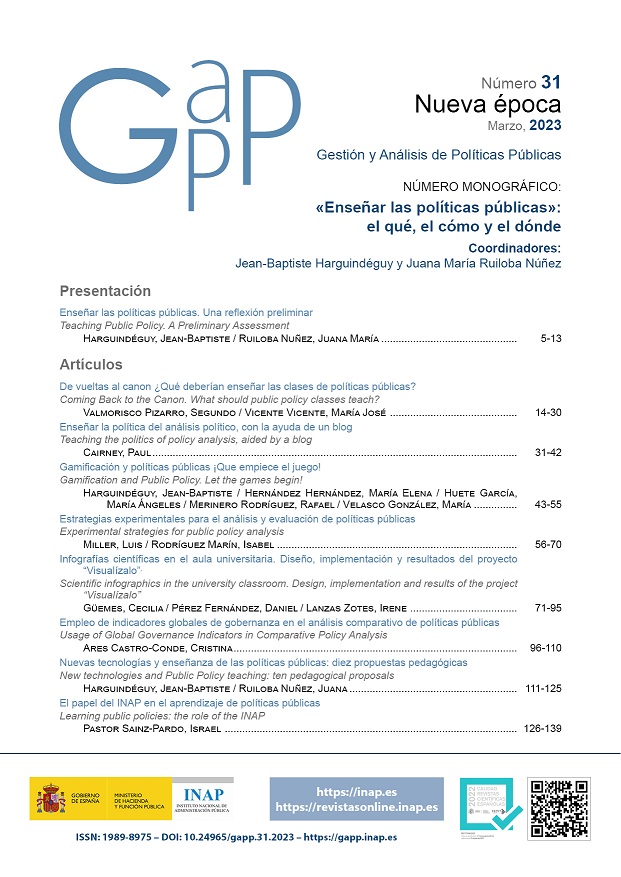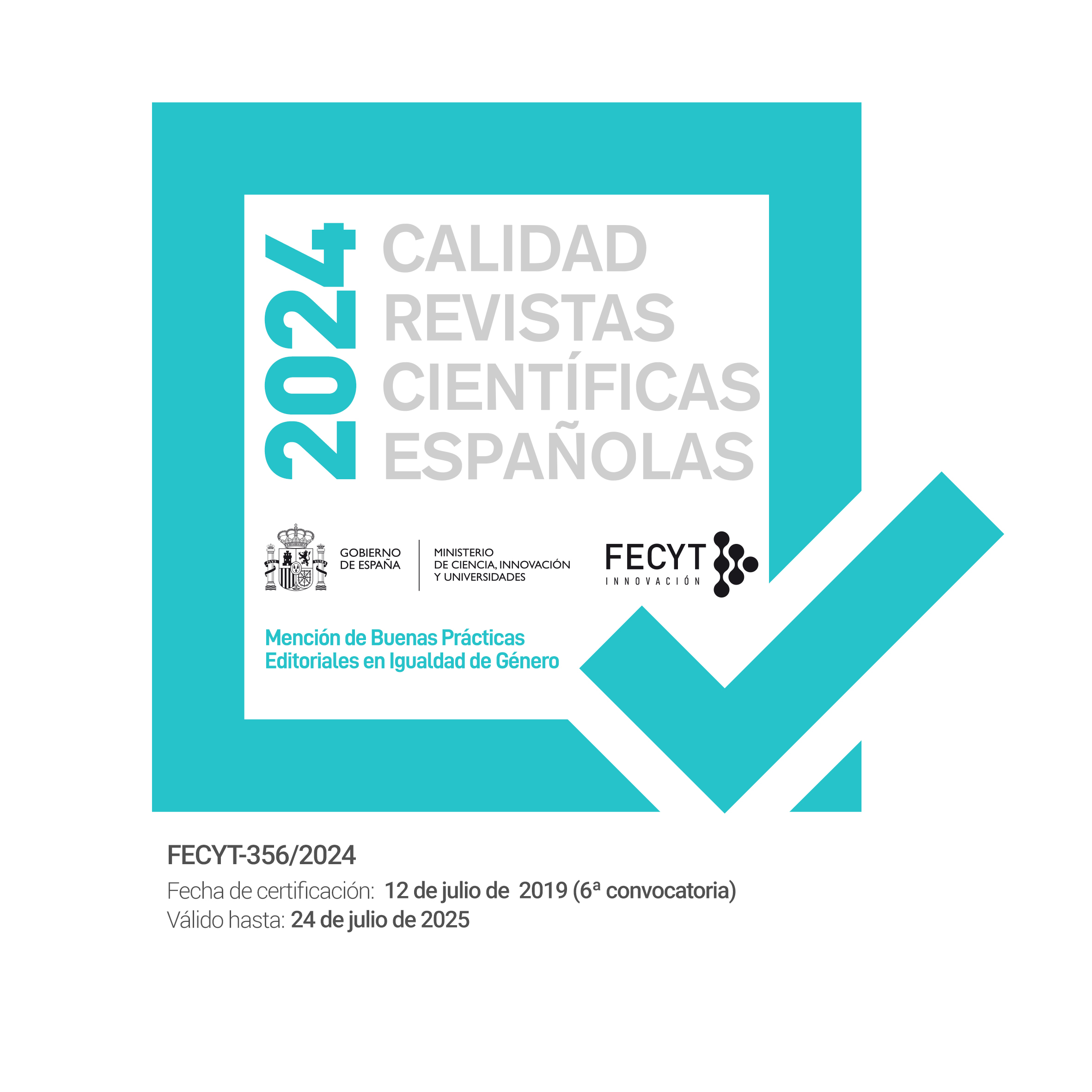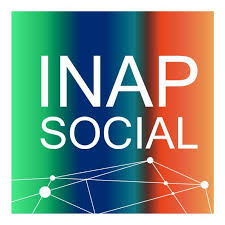New technologies and Public Policy teaching: ten pedagogical proposals
DOI:
https://doi.org/10.24965/gapp.11134Keywords:
Teaching, public policy, computing, pedagogical innovationAbstract
The use of new technologies in higher education is now a basic instrumental skill for students. However, there are few available sources to help university professors to choose the right applications for their classes. This pedagogical proposal is based on a selection of applications of interest for teachers and students in policy analysis which aims to maintain the balance between pedagogy and technology. These applications are designed to develop skills related with the public policy cycle, along with transversal issues like policy actors, institutions, ideas and territoriality. Each application is evaluated according to three variables: it must be free-of-charge, accessible and stable. The paper also includes some comments about their graphic interface and operability.
Downloads
References
Adler, M. y Ziglio, E. (1996). Gazing into the oracle: The Delphi method and its application to social policy and public health. Jessica Kingsley Publishers.
Ampadu, E. y Sedofia, J. (2021). COVID-19 and Emergency Education Strategies in University of Ghana: Students’ Challenges with Emergency Remote Learning. En C. Bissessar (ed.), Emergency Remote Learning, Teaching and Leading: Global Perspectives (pp. 21-36). Springer. https://link.springer.com/chapter/10.1007/978-3-030-76591-0_2
ANECA (2015). Libro Blanco. Título de Grado en Ciencias Políticas y de la Administración, Sociología y Gestión y Administración Pública. Agencia Nacional de Evaluación de la Calidad y Acreditación. https://www.aneca.es/documents/20123/63950/libroblanco_politicas_def.pdf/450657b0-a47b-c17c-e58d-39491412173f?t=1654601688983
Area-Moreira, M., Bethencourt-Aguilar, A., Martin-Gomez, S., y Nicolas-Santos, S. (2021). Análisis de las políticas de enseñanza universitaria en España en tiempos de Covid-19. La presencialidad adaptada. Revista de Educación a Distancia – RED, 21(65), 1-19. https://revistas.um.es/red/article/view/450461
Barnes, J. A. (1954). Class and committees in a Norwegian island parish. Human Relations, 7(1), 39-58. https://doi.org/10.1177/001872675400700102
Bates, A. W. (2019). Teaching in a Digital Age. Guidelines for Designing Teaching and Learning. Tony Bates Associates.
Bayne, S., Evans, P., Ewins, R., Knox, J., Lamb, J., Macleod, H., O’Shea, C., Ross, J., Sheail, P. y Sinclair, C. (2020). The Manifesto for Teaching Online. The MIT Press.
Ben Youssef, A. y Ragni, L. (2008). Uses of educational information and communication technologies: From digital divides to digital trajectories. RUSC. University and Knowledge Society Journal, 5(1), 70-82. http://dx.doi.org/10.7238/rusc.v5i1.327
Bou-Hamad, I. (2020). The impact of social media usage and lifestyle habits on academic achievement: Insights from a developing country context. Children and Youth Services Review, (118), article 105425. https://doi.org/10.1016/j.childyouth.2020.105425
Cañas, A. J. y Novak, J. D. (2014). Concept Mapping Using CmapTools to Enhance Meaningful Learning. En A. Okada (ed.), Knowledge Cartography: Software Tools and Mapping Techniques (pp. 23-45). Springer-Verlag. https://link.springer.com/chapter/10.1007/978-1-4471-6470-8_2
Carmines, G. y Zeller, R. (1979). Reliability and Validity Assessment. Quantitative Applications in the Social Sciences. Sage Publications.
Cobb, R. y Elder, C. (1972). Participation in American Politics. The Dynamics of Agenda Building. John Hopkins University Press.
Coral, M. A. y Bernuy, A. E. (2022). Challenges in the digital transformation processes in higher education institutions and universities. International Journal of Information Technologies and Systems Approach. 15(1), 1-14. http://doi.org/10.4018/IJITSA.290002
Duart, J. M. y Sangrà, A. (2000). Formación universitaria por medio de la Web: un modelo integrador para la educación superior. En J. Duart y A. Sangrà (eds.), Aprender en la virtualidad (pp. 23-50). Gedisa: Universitat Oberta de Catalunya.
Eco, U. (1965). Apocalípticos e integrados. Lumen.
Elmore, R. F. (1979). Backward mapping: Implementation research and policy decisions. Political Science Quarterly, 94(4), 601-616.
Englund, C., Olofsson, A. D. y Price, L. (2017). Teaching with technology in higher education: Understanding conceptual change and development in practice. Higher Education Research & Development, 36(1), 73-87. https://doi.org/10.1080/07294360.2016.1171300
Fawns, T. (2022). An entangled pedagogy: Looking beyond the pedagogy-technology dichotomy. Postdigital Science and Education, (4), 711-728. https://doi.org/10.1007/s42438-022-00302-7
Felstiner, W. L. F., Abel, R. L. y Sarat, A. (1980). The emergence and transformation of disputes: naming, blaming, claiming. Law and Society Review, 15(3-4), 631-654. http://www.jstor.org/stable/3053505
Fielding, N. G. y Lee, R. M. (1998). Computer Analysis and Qualitative Research. Sage.
Harguindéguy, J. B. (2020). Análisis de políticas públicas. Tecnos.
Heywood, D. I., Cornelius, S. C. y Carver, S. J. (2006). An Introduction to Geographical Information Systems. Prentice Hall.
Hooghe, L. y Marks, G. (2001). Multi-level Governance and European Integration. Rowman and Littlefield Publishers.
Howlett, M. (2019). Designing Public Policies Principles and Instruments. Routledge.
Hvid Stenalt, M. (2021). Researching student agency in digital education as if the social aspects matter: Students’ experience of participatory dimensions of online peer assessment. Assessment & Evaluation in Higher Education, 46(4), 644-658. https://doi.org/10.1080/02602938.2020.1798355
Janda, K. (1967). Some Computer Applications in Political Science. Computers and the Humanities, 2(1), 12-16. http://www.jstor.org/stable/30203944
Koehler, M. J., Mishra, P. y Cain, W. (2013). What is technological pedagogical content knowledge (TPACK)? Journal of Education, 193(3), 13-19. https://doi.org/10.1177/002205741319300303
MacKenzie, A., Bacalja, A., Annamali, D., Panaretou, A., Girme, P., Cutajar, M., Abegglen, S., Evens, M., Neuhaus, F., Wilson, K., Psarikidou, K., Koole, M., Hrastinski, S., Sturm, S., Adachi, Ch., Schnaider, K., Bozkurt, A., Rapanta, Ch., Themelis, Ch., Thestrup, K. et al. (2021). Dissolving the dichotomies between online and campus-based teaching: A collective response to the Manifesto for teaching online. Postdigital Science and Education, 4(2), 271-329. https://link.springer.com/article/10.1007/s42438-021-00259-z
March, J. G. y Olsen, J. P. (1983). The new institutionalism: Organizational factors in political life. American Political Science Review, 78(3), 734-749. https://doi.org/10.2307/1961840
McCombs, M. E. y Shaw, D. L. (1972). The agenda-setting function of mass media. The Public Opinion Quarterly, 36(2), 176-187. http://www.jstor.org/stable/2747787
Mercader, C. y Gairín, J. (2020). University teachers’ perception of barriers to the use of digital technologies: the importance of the academic discipline. International Journal of Educational Technology in Higher Education, 17(4), https://doi.org/10.1186/s41239-020-0182-x
Miliken, J. y Barnes, L. (2002). Teaching and technology in higher education: Student perceptions and personal reflections. Computers & Education, 39(3), 223-235. https://doi.org/10.1016/S0360-1315(02)00042-8
Notorio, A. et. al. (1992). El mapa conceptual como técnica cognitiva y su proceso de elaboración. Narcea.
Novak, J. D. (1995). Teoría y práctica de la educación. La teoría del aprendizaje asimilativo de David Ausubel. Alianza Editorial.
Nussbaum, V. (2014). Le mur d’images au cinéma et à la télévision: mise en lumière d’un dispositif de projection mentale. Intermédialités / Intermediality, 24-25. https://doi.org/10.7202/1034168ar
Pavlopoulos, G. A., Paez-Espino, D., Kyrpides, N. C. y Iliopoulos, I. (2017). Empirical comparison of visualization tools for larger-scale network analysis. Hindawi. Advances in Bioinformatics, article 1278932. https://doi.org/10.1155/2017/1278932
Peña, D. y Romo, J. (1997). Introducción a la estadística para las ciencias sociales. McGraw-Hill.
Pressman, J. L. y Wildavsky, A. B. (1973). Implementation. University of California Press.
Prisacari, A. A. y Danielson, J. (2017). Computer-based versus paper-based testing: Investigating testing mode with cognitive load and scratch paper use. Computers in Human Behavior, (77), 1-10. https://doi.org/10.1016/j.chb.2017.07.044
Ragin, C. C. (1987). The Comparative Method: Moving Beyond Qualitative and Quantitative Strategies. University of California Press.
Roig-Tierno, N., Gonzalez-Cruz, T. F. y Llopis-Martinez, J. (2017). An overview of qualitative comparative analysis: A bibliometric analysis. Journal of Innovation & Knowledge, 2(1), 15-23. https://doi.org/10.1016/j.jik.2016.12.002
Routabi, A. y Bennani, B. (2022). The impact of the pedagogical integration of NICTs on student satisfaction during COVID-19: The case of University Hassan II of Casablanca, Morocco. En M. Haoucha (ed.), Policies and Procedures for the Implementation of Safe and Healthy Educational Environments. Post-COVID-19 Perspectives (pp. 218-236). IGI Global. https://doi.org/10.4018/978-1-7998-9297-7.ch013
Sabatier, P. A. (1986). Top-down and bottom-up approaches to implementation research: A critical analysis and suggested synthesis. Journal of Public Policy, 6(1), 21-48. https://doi.org/10.1017/S0143814X00003846
Sabatier, P. A. (1988). An advocacy coalition framework of policy change and the role of policy-oriented learning therein. Policy Sciences, 21(2-3), 129-168. https://doi.org/10.1007/BF00136406
Seeman, N. (2000). Software for tyrants. Harvard proudly markets PolicyMaker 2.2 as a program that will help politicians get what they want. The Weekly Standard, 5(47), 29-30. https://search.opinionarchives.com/TWS_Web/digitalarchive.aspx
Selwyn, N. (2007). The use of computer technology in university teaching and learning: A critical perspective. Journal of Computer Assisted Learning, 23(2), 83-94. https://doi.org/10.1111/j.1365-2729.2006.00204.x
Selwyn, N. (2022). Less work for teacher? The ironies of automated decision-making in schools. En S. Pink, M. Berg, D. Lupton y M. Ruckenstein (eds.), Everyday Automation: Experiencing and Anticipating Emerging Technologies (pp. 73-86). Routledge. https://doi.org/10.4324/9781003170884-6
Selwyn, N., Pangrazio, L., Nemorin, S. y Perrotta, C. (2020). What might the school of 2030 be like? An exercise in social science fiction. Learning, Media and Technology, 45(1), 90-106. https://doi.org/10.1080/17439884.2020.1694944
Trepat Carbonell, C. A. y Rivero García, M. P. (2010). Didáctica de la historia y multimedia expositiva. Graó.
Walker, Z., Kho, H. H., Tan, D. y Lim, N. (2020). Practicum teachers’ use of mobile technology as measured by the technology acceptance model. Asia Pacific Journal of Education, 40(2), 230-246. https://doi.org/10.1080/02188791.2019.1671808
Ward, M. D., Stovel, K. y Sacks, A. (2011). Network analysis and political science. Annual Review of Political Science, 14(1), 245-264. https://doi.org/10.1146/annurev.polisci.12.040907.115949
Wilson, S. L. y Herrera, Y. M. (2019). Teaching computerized content analysis for undergraduate research papers. PS: Political Science & Politics, 52(3), 536-542. https://doi.org/10.1017/S104909651900026X
Downloads
Published
How to Cite
Issue
Section
License
Copyright (c) 2022 Gestión y Análisis de Políticas Públicas

This work is licensed under a Creative Commons Attribution-NonCommercial 4.0 International License.












